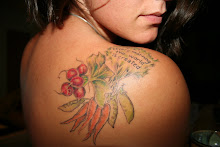
Fall has officially arrived!! For me that means lots of warm soups and filling the house with baby pumpkins and dried Indian corn.
Last week while celebrating Rosh Hashanah (the Jewish New Year) at my parents house in Michigan, I got to cook with some farm fresh autumnal ingredients, straight out of their CSA box and my mom’s garden. Being the beginning of fall, there was a ton of squash and also some carrots, so we decided to make a creamed squash soup. Because it’s traditional to eat apples and honey in honor of a sweet new year, we kicked up this recipe a bit by adding apples to the soup itself, and also using them for the garnish.
Winter squash, like the ones I used in this recipe, are great to eat as the weather cools down because of their warming qualities. They’re said to be medicinal for stomach problems and helpful in improving energy circulation. Winter squash and carrots are some of the vegetables highest in carotenoids, the fat-soluble pigments found in many red, orange and yellow foods. Carotenoids are a great source of vitamin A and they act as natural anticarcinogenics & antioxidants (meaning they help fight off harmful free radicals in the body and protect cells and tissues).
Below are two recipes – one for the carrot & squash apple curry soup, and another for a plain veggie stock. To those who are celebrating Rosh Hashana, have a happy & sweet new year!
Curried Squash Soup with Apples
serves 10-12 people

4 small carrots
2 butternut squash (save the seeds for roasting!)
1 delicata squash
1 teaspoon turmeric
½ teaspoon cumin
½ teaspoon coriander
1 teaspoon curry powder
1 small onion
3 cloves garlic, minced
1 small potato, medium dice
1 cup finely diced apple
1 tablespoon + 1 tablespoon extra virgin olive oil
2 tablespoons ginger juice, or more to taste
7 cups vegetable stock (recipe below)
2 teaspoons sea salt or more to taste
1 honeycrisp apple, for garnish
1. Preheat oven to 400. Rough chop carrots & squash (removing squash skin), and toss with 1 tablespoon olive oil, ¼ teaspoon turmeric, ¼ teaspoon cumin and ¼ teaspoon coriander. Spread squash & carrots on a baking sheet and roast for 30 minutes or until gently browned.

2. In a large saucepan, add remaining olive oil and turn heat to medium. When oil is hot, add onions and sauté for 5 minutes, adding garlic midway through & stirring frequently so as not to brown. Add roasted veggies, potatoes, apples, stock and remaining spices, and bring to a boil.
3. Turn heat down to a simmer and cook partially covered for 45 minutes, stirring occasionally, until all veggies are soft. Set aside a cup or two of the cooking liquid. Using a blender or immersion blender (I like to wait for the soup to cool a bit if using a regular blender), completely blend the soup until thick and creamy. At this point, feel free to add back the reserved cooking liquid, as well as any extra stock as needed for desired consistency. (The soup should be thick enough that it coats the back of the spoon when lifted up, but should pour smoothly from the spoon, not in chunks.)
4. Once thoroughly blended, place soup back on low heat. Grate a piece of ginger about 2” long, gathering all of the liquid and pulp that is released. Squeeze the pulp over the soup until you have released all of the ginger juice. Continue as needed to taste. If you want a stronger apple flavor you can do the same with an apple. Add salt and stir well.
5. If you have time, let the soup sit off the heat for 2 hours or so to allow flavors to strengthen.
5. Slice apple into ¼” rounds and cut into small dices. These are only for garnish so it’s most important that the sizes are consistent. Place about a tablespoon of apple dices in the center of each bowl of soup.
* * *
Veggie Stock
yields 5 quarts
1 tablespoon olive oil + 1 tablsepoon olive oil
2 pieces parsnip with leaves
1 potato
1 leek
3 carrots
2 pieces celery
½ large onion
3 cloves garlic
celery leaves
1. Preheat oven to 400. Rough chop all veggies except onion & garlic into approximately 1” pieces. Toss in olive oil and roast for 30 minutes.

2. Cut onion into medium dice, peel garlic & chop in half. Heat a large saucepan on medium, adding remaining 1 tablespoon olive oil. Add onions and garlic, stir frequently so as not to brown. Add vegetables and 5 quarts of water. Bring to a boil, turn heat down and simmer for 45 minutes to an hour.

3. Strain stock completely, squeezing veggies tightly to extract as much liquid as possible. Add salt to taste, if desired. Discard veggies. Stock will hold 4-5 days in the fridge, or can be kept frozen for several months.













